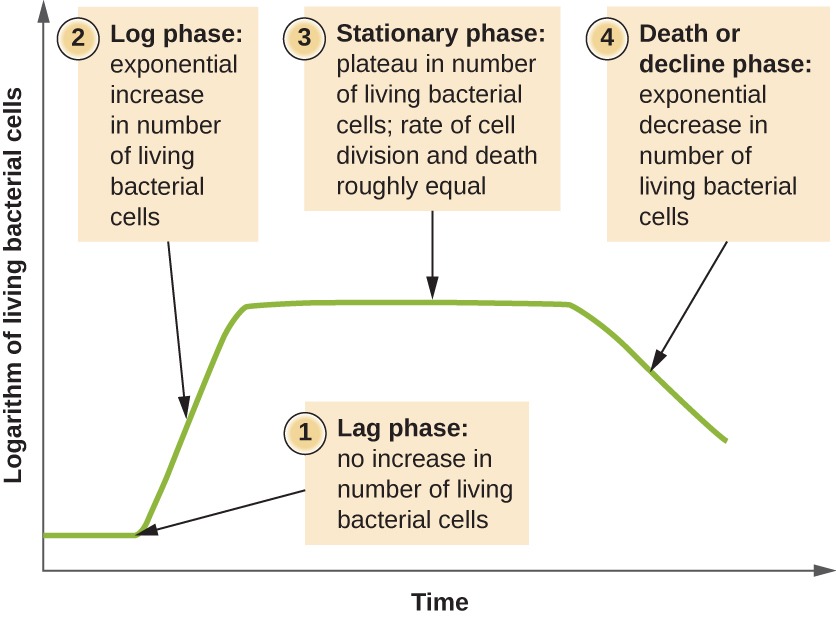Bacterial growth curve
Definition
When a few bacteria are inoculated into a liquid growth medium or any solid culture media and the population is counted at intervals, it is possible to plot a bacterial growth curve that shows the growth of cells over time.
Growth
- It is orderly increase in a cellular constituent.
- When microorganisms reproduce by binary fission or budding then it also leads to increase in the number of cells.
Growth curve
- Growth of microbial population is measured periodically by plotting log number of viable bacteria against time on a graph then it gives a characteristics curve which is also called as growth curve or growth cycle.
- Due to exponential bacterial growth pattern, the growth curve of microbial population is hyperbolic.
- In batch culture, there is an initial phase of no growth (lag phase), which is followed by rapid growth (exponential growth), then there is leveling off (stationary phase) and finally a decline in the viable cell count (death or decline phase).
- Between each of these phases, there is a transition period (curve portion).
Different phases of bacterial growth curve
- Lag phase
- Log phase or exponential phase
- Stationary phase
- Death or decline phase

Lag phase
- On adding microorganisms into a fresh culture medium, usually no immediate doubling of the population, so this period is called the Lag phase.
- During this phase microorganisms does not grow or divide immediately, but take sometimes to adjust to the environment, so this phase is also called adaptation phase.
- But this does not mean that the cells are dormant; on the contrary, during this stage the individual cells increases in size beyond their normal dimensions.
- At the end of the phase, microorganisms are well prepared for the for the cell division.
Exponential phase
- During exponential phase, microbial cells are divides at the maximal rate possible given their genetic potential, the nature of the medium and the conditions under which they are growing.
- Growth of microorganisms during this phase is constant and there is doubling in number at regular interval.
- Microbial Growth during this phase is balanced, means all the cellular constituents are produced at a constant rate relative to each other.
- During this period on plotting log of the number against time results produces straight line.
- In this of growth, population is most nearly uniform in terms of metabolic activity, chemical composition of cells and other physiological characteristics.
Stationary phase
- The phase during which growth reaches a state where there is no net increase in the population, is called stationary phase.
- Due to a closed system, eventually population growth of microorganisms ceases during this phase and the growth curve becomes horizontal.
- The population remains constant because of balance between reproduction rate and equivalent death rate or the growth of the population ceases but remain metabolically active.
- Microbial population enters into the stationary due to several reasons, increased bacterial cell density, depletion of nutrition, oxygen limitation, growth of microorganisms is slow and accumulation of the toxic secondary metabolites.
Death or decline phase
- During death phase, number of viable cells is decreases exponentially at constant rate.
- Bacteria die at different rate as they grow at different rates.
- It was assumed that the variety of environmental conditions causes death of the microorganisms like depletion of essential nutrients and the buildup of toxic wastes.
Measurement of microbial growth
- Microbial growth can be determined in number of ways to determine growth rates and generation times.
Different methods of measurement of microbial growth
| Method | Applications | Expression of growth |
| Microscopic count | Enumeration of bacteria in cultures and vaccines. | Number of cells per ml |
| Electronic enumerations | Same as for microscopic count | Same as for microscopic count |
| Plate count | Enumeration of bacteria in foods, milk, cultures, soil, etc. | Colony forming units per ml |
| Membrane filter | Same as that for plate count | Same as that for plate count |
| Turbidimetric measurement | Microbiological assay, estimation of cell count in cultures, broth or aqueous suspensions. | Optical density(absorbance) |
| Nitrogen determination | Measurement of the cell count from heavy culture suspensions to be used for research in metabolism. | Mg nitrogen in ml |
Reference and Sources
- https://www.onlinebiologynotes.com/bacterial-growth-curve/
- https://biologywriteup.blogspot.com/2014/10/control-of-microbial-growth-bacterial.html
- https://jogindra-singh.blogspot.com/2011/12/microbial-growth.html
- https://www.coursehero.com/tutors-problems/Biology/9316896-What-are-the-four-phrases-of-the-bacterialgrowth-curve/

I really got the exact information i was looking for on the topic, Bacterial Growth Curve and honestly i like this website
Wow this Web is really helping I really got the correct type of notes about the bacterial growth curve thanks so much